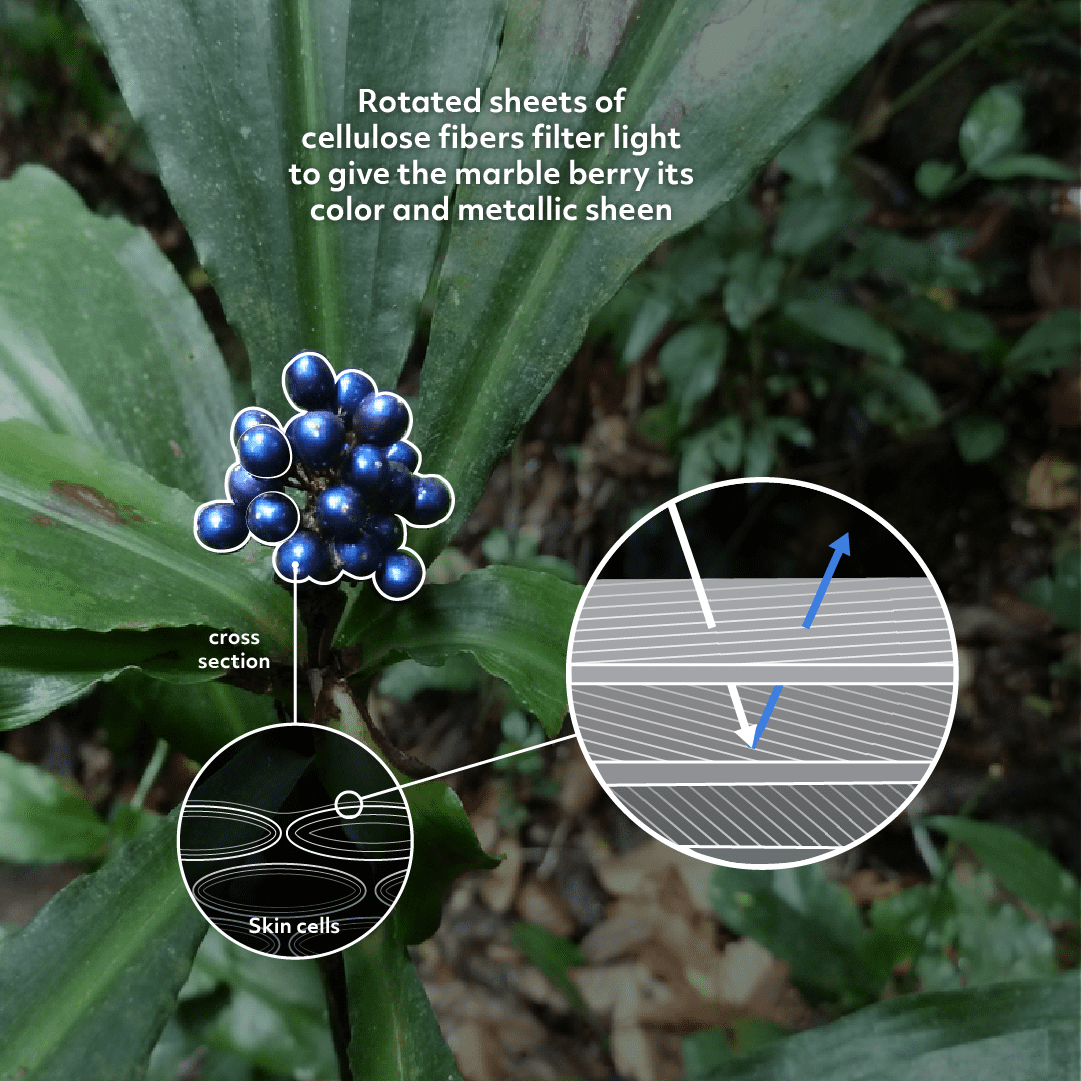The skin of the marble berry has a bright blue pointillist appearance due to distinct reflection of color on layers of cellulose microfibrils.
Introduction
The fruit of Pollia condensata, a plant native to the forests of Africa, is renowned for its extraordinary vibrant blue color, giving it the name “marble berry.” Unlike other plants that rely on s for coloration, Pollia fruit achieves its striking appearance through a unique structural . This fruit, often found in the understory of forests from the Ivory Coast to Ethiopia and south to Angola and Mozambique, showcases nature’s brilliance by reflecting light in a way that creates an intense, iridescent blue color. This feature is not only visually stunning but also serves important ecological functions.
The Strategy
The Pollia condensata fruit’s brilliant blue color is caused by structural coloration, a phenomenon that arises from the physical structure of its cells rather than from pigments. Specifically, the fruit’s epicarp, or outer layer, contains cells whose walls are composed of helicoidally stacked microfibrils. These microfibrils are arranged in a spiral or helicoidal pattern, and their precise organization leads to a process called constructive interference, which is responsible for the fruit’s vibrant colors.
Constructive interference occurs when light waves reflect off multiple layers within a material and combine in such a way that certain wavelengths of light are amplified. In the case of the Pollia fruit, the layers of cellulose microfibrils are spaced at distances that correspond to specific wavelengths of visible light, particularly in the blue region of the spectrum. When light hits these layers, some of it reflects off the surface of each microfibril layer. The reflected waves combine, and if their crests and troughs are aligned (in phase), they amplify each other, making the reflected light appear much more intense. This selective reflection creates the intense blue color, while the specific spacing and thickness of the cellulose layers determine which wavelengths are reflected.
What makes Pollia’s coloration even more striking is the variation in layer thickness from cell to cell. Each cell reflects light differently, resulting in a pixelated or pointillist effect where different shades of blue, green, and purple appear across the surface of the fruit. This is why the fruit’s color appears vibrant, multi-toned, and almost alive with shifting hues depending on the angle of observation.
Unlike spherical cells, which reflect light symmetrically, the elongated cells of Pollia’s epicarp create directionality in the reflection. The multilayer structure within each cell is curved, so only certain parts of the cell are oriented in a way that they reflect light directly back toward the observer. As a result, the fruit’s surface appears as a series of bright spots, with color varying from cell to cell depending on their orientation relative to the light source and the viewer’s position.
The oblong shape of the cells also means that the reflected color changes as the angle of observation changes. When viewed from different angles, the curved multilayer structure causes the light to reflect at varying angles, producing different effects depending on how the layers align with the incident light. This is similar to the iridescence seen in butterfly wings or beetle shells, where the color shifts as the angle of light changes.
Another intriguing aspect of Pollia’s coloration is that the reflected light is circularly polarized. Circular polarization occurs when light waves rotate in a circular motion as they travel. In Pollia fruit, this happens because the cellulose microfibrils in the cell walls are arranged in a helicoidal pattern, which interacts with the light in a way that makes it rotate. The handedness of this helicoidal structure—whether it spirals to the left or right—determines whether the reflected light is left-handed or right-handed circularly polarized. This property adds another layer of complexity to how the fruit’s color is perceived. The fruit’s ability to reflect both left- and right-handed polarized light is a unique feature that further enhances the intensity and richness of its colors.
The Potential
The Pollia condensata fruit’s pointillist structural coloration offers exciting possibilities for , particularly in the fields of materials science and design. One potential application is in creating colorfast materials that do not fade over time. Since the color of Pollia fruits is structural, it does not degrade like pigment-based colors. This could lead to the development of textiles, coatings, and paints that maintain their vibrant colors indefinitely without the use of synthetic dyes or pigments.
Another promising area is in the development of security features for currency and identification documents. The unique polarized light reflection and intense, non-fading color can be used to create counterfeit-resistant materials. By mimicking the fruit’s structural coloration, it is possible to produce security features that are both visually distinctive and difficult to replicate.
Furthermore, the Pollia fruit’s structural coloration can inspire sustainable and environmentally friendly production methods. Unlike traditional dyeing processes that often involve toxic chemicals and high energy consumption, producing colors through structural means can be done with minimal environmental impact. This aligns with principles of sustainability and circularity, offering a path to more eco-friendly manufacturing practices.
AI on AskNature
This page was produced in part with the assistance of AI, which is allowing us to greatly expand the volume of content available on AskNature. All of the content has been reviewed for accuracy and appropriateness by human editors. To provide feedback or to get involved with the project, contact us.







